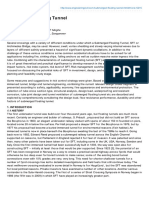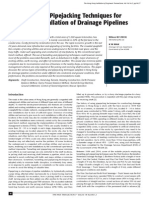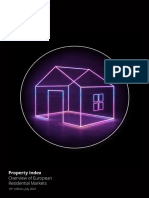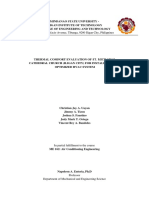Appu NLK
Appu NLK
Uploaded by
gowthami sirana balu0 ratings0% found this document useful (0 votes)
30 views1 pageThe document discusses submerged floating tunnels (SFT), a new concept for tunnels that float underwater supported by buoyancy at a depth of 20-50m. An SFT utilizes waterways to carry traffic under water between land masses. It discusses the structural components of an SFT tube and challenges such as transporting tunnel segments, anchoring, preventing collisions, and providing escape doors. Benefits of SFTs include maintaining landscape beauty, reducing energy use and pollution, and providing communities with improved transportation options.
Original Description:
mlk
Original Title
Appu nlk
Copyright
© © All Rights Reserved
Available Formats
PPTX, PDF, TXT or read online from Scribd
Share this document
Did you find this document useful?
Is this content inappropriate?
Report this DocumentThe document discusses submerged floating tunnels (SFT), a new concept for tunnels that float underwater supported by buoyancy at a depth of 20-50m. An SFT utilizes waterways to carry traffic under water between land masses. It discusses the structural components of an SFT tube and challenges such as transporting tunnel segments, anchoring, preventing collisions, and providing escape doors. Benefits of SFTs include maintaining landscape beauty, reducing energy use and pollution, and providing communities with improved transportation options.
Copyright:
© All Rights Reserved
Available Formats
Download as PPTX, PDF, TXT or read online from Scribd
Download as pptx, pdf, or txt
0 ratings0% found this document useful (0 votes)
30 views1 pageAppu NLK
Appu NLK
Uploaded by
gowthami sirana baluThe document discusses submerged floating tunnels (SFT), a new concept for tunnels that float underwater supported by buoyancy at a depth of 20-50m. An SFT utilizes waterways to carry traffic under water between land masses. It discusses the structural components of an SFT tube and challenges such as transporting tunnel segments, anchoring, preventing collisions, and providing escape doors. Benefits of SFTs include maintaining landscape beauty, reducing energy use and pollution, and providing communities with improved transportation options.
Copyright:
© All Rights Reserved
Available Formats
Download as PPTX, PDF, TXT or read online from Scribd
Download as pptx, pdf, or txt
You are on page 1of 1
SUBMERGED FLOATING TUNNELS
S B GOWTHAMI
CIVIL ENGINEERING
INTRODUCTION
STRUCTURAL COMPONENTS
TUBE
CHALLENGES TO BE FACED IN
SFT
Tunnels in water are by no means new in civil engineering. But
tunnel is a totally new concept and never used before even for
very small lengths. It is a tunnel that floats in water supported
by its buoyancy. It is generally placed at a depth of 20-50m
from the water level. The Submerged floating tunnel utilizes
lakes and waterways to carry traffic under water and on to the
other side, where it can be conveniently linked to the rural
network or to the underground infrastructure of modern cities.
Removal of
Polluted Air
& Proper
Lighting
ANCHORING
PONTOO
NS
NEED FOR SFT
CONSTRUCTION
Prevention Of
Collisions &
Provision of
Escape Doors
CONCLUSIONS
1:Suspension bridge 2:Submerged floating tunnel
3:Immersed tube 4:Undersea tunnel
PRINCIPLE OF SFT
BUOYANCY 0.5 0.8
WEIGHT
Transporting
the Tunnel
Segments to
their Final
Places
Construction
of Tunnel
Segments
The submerged floating tunnel will set up new trends in
transportation engineering and which shows with the
advances in technology that will reduce the time required for
travelling. And make the transportation more effective by
hiding the traffic under water by which the beauty of
landscape is maintained and valuable land is available for
other purposes. Benefits can be obtained with respect to less
energy consumption, air pollution and reduced noise
. emission. For wide and deep crossings the submerged
floating tunnel may be the only feasible fix link, replacing
present day ferries and providing local communities with new
opportunities for improved communication and regional
development.
You might also like
- Submerge Floating TunnelDocument14 pagesSubmerge Floating TunnelSandip Jagdale100% (1)
- Asi-X Packer: DescriptionDocument5 pagesAsi-X Packer: DescriptionPARAGNo ratings yet
- Submerged Floating Tunnels: A Seminar Report OnDocument17 pagesSubmerged Floating Tunnels: A Seminar Report OnPragati PotdukheNo ratings yet
- Abstract 5Document2 pagesAbstract 5Anuvind JPNo ratings yet
- Submerged Floating REPORTDocument18 pagesSubmerged Floating REPORTphoenix26199282% (11)
- Submerged Floating TunnelsDocument15 pagesSubmerged Floating TunnelsVijay PowarNo ratings yet
- Submerg Floating Tunnel2Document24 pagesSubmerg Floating Tunnel2gowthami sirana baluNo ratings yet
- Submerged Floating TunnelDocument24 pagesSubmerged Floating TunnelRohith Reddy60% (5)
- Submerged TunnelDocument18 pagesSubmerged TunnelRakesh HNo ratings yet
- Underground Railway TunnelingDocument38 pagesUnderground Railway TunnelingSudeep SharmaNo ratings yet
- Civil Submerged Floating TunnelsDocument15 pagesCivil Submerged Floating TunnelsSiddeshwar Patil100% (1)
- Immersed TunnelsDocument2 pagesImmersed TunnelsSaeed DelaraNo ratings yet
- Report On Super PassageDocument59 pagesReport On Super PassageLohithReddy100% (10)
- wtc2015 - URBAN TUNNELLING THE VAUXHALL UNDERGROUND STATION UPGRADE SEE TUNNELDocument7 pageswtc2015 - URBAN TUNNELLING THE VAUXHALL UNDERGROUND STATION UPGRADE SEE TUNNELMishNo ratings yet
- Submerged Floating Tunnels: Seminar OnDocument15 pagesSubmerged Floating Tunnels: Seminar OnIrfan KhanNo ratings yet
- 205 Paper 350 - Design of The SMART Project-ADocument12 pages205 Paper 350 - Design of The SMART Project-Aodri5No ratings yet
- Abstract+paper 1615119 Hong Kong Zhuhai Macao LinkDocument18 pagesAbstract+paper 1615119 Hong Kong Zhuhai Macao LinkAnonymous zpNy2bltNo ratings yet
- Submerged Floating Tunnel: Priya Kumari, Mamta ShahDocument9 pagesSubmerged Floating Tunnel: Priya Kumari, Mamta ShahMateen KhanNo ratings yet
- Under Ground RailwayDocument38 pagesUnder Ground RailwaySandip JagdaleNo ratings yet
- Underwater TunnelingDocument19 pagesUnderwater Tunnelingrahuldasbi100% (1)
- Prague Metro - Line C Extension: J. KunakDocument6 pagesPrague Metro - Line C Extension: J. KunakHarold TaylorNo ratings yet
- University of GondarDocument171 pagesUniversity of Gondaralamrew siyoum80% (5)
- Transatlantic TunnelDocument37 pagesTransatlantic TunnelAshutosh SinghNo ratings yet
- Transatlantic Tunnel (Floating Tunnel)Document37 pagesTransatlantic Tunnel (Floating Tunnel)Tamboli EnergiNo ratings yet
- Submerged Floating TunnelDocument9 pagesSubmerged Floating TunnelPriyankaNo ratings yet
- Ce 405 Module 2 IntakesDocument27 pagesCe 405 Module 2 IntakesHarikrishnan PsNo ratings yet
- Submerged Floating TunnelDocument12 pagesSubmerged Floating TunnelHarsha Vardhan MeduriNo ratings yet
- Micro TunnellingDocument9 pagesMicro TunnellingShamitha KanchanaNo ratings yet
- Jay PrakashDocument14 pagesJay PrakashAKNo ratings yet
- 1502 HOBAS PipeLine Railway JackingDocument12 pages1502 HOBAS PipeLine Railway Jackingbaby_osianaNo ratings yet
- 1502 HOBAS-PipeLine Railway-Jacking PDFDocument12 pages1502 HOBAS-PipeLine Railway-Jacking PDFSaif AlkatbNo ratings yet
- Large Landslide Stabilization by Deep Drainage WellsDocument8 pagesLarge Landslide Stabilization by Deep Drainage WellsCarlos Eduardo Torres RomeroNo ratings yet
- SFT Report RevisedDocument16 pagesSFT Report RevisedPrayas BhendeNo ratings yet
- Donghai Bridge - The First Super Long Open Sea Crossing in ChinaDocument6 pagesDonghai Bridge - The First Super Long Open Sea Crossing in ChinaHossein DoudiNo ratings yet
- 2019 Sugden Award Senthilnath. G.T.Document15 pages2019 Sugden Award Senthilnath. G.T.الكعبه السماويهNo ratings yet
- Jaya Patil2815Document8 pagesJaya Patil2815jayeshbaviskar9501No ratings yet
- (22403) Rbe Microproject-2Document11 pages(22403) Rbe Microproject-2saikrishnamithapalli053No ratings yet
- Submerged Floating TunnelsDocument11 pagesSubmerged Floating TunnelsmaniNo ratings yet
- 16-27 - 735 - HkieDocument12 pages16-27 - 735 - HkieWilson MokNo ratings yet
- Libro Ingles 2Document28 pagesLibro Ingles 2DIEGUS GoNo ratings yet
- 22 - Outlet Works Through Dams and River IntakesDocument7 pages22 - Outlet Works Through Dams and River IntakesDeroNo ratings yet
- Final Report (Hydrolic Structure 2)Document30 pagesFinal Report (Hydrolic Structure 2)Ahmed AmediNo ratings yet
- Lecture 29Document8 pagesLecture 29monirul islamNo ratings yet
- Permanent Secant Pile Wall For Underground TransitDocument9 pagesPermanent Secant Pile Wall For Underground Transitshiralrohan10No ratings yet
- Connecting Line 2 To Line 1. Bilbao Metro.: IMEBISA (Bilbao Underground Engineering)Document5 pagesConnecting Line 2 To Line 1. Bilbao Metro.: IMEBISA (Bilbao Underground Engineering)Harold TaylorNo ratings yet
- Suspension Bridge: A Project Seminar ReportDocument30 pagesSuspension Bridge: A Project Seminar Reportayushj0% (1)
- Adoption and Use of Submerged Floating Tunnels: Seminar ReportDocument6 pagesAdoption and Use of Submerged Floating Tunnels: Seminar ReportPrayas BhendeNo ratings yet
- Special Topic Report by Sadiq MerchantDocument26 pagesSpecial Topic Report by Sadiq MerchantMuhammad Sadiq MerchantNo ratings yet
- Millennium Bridge PDFDocument8 pagesMillennium Bridge PDFPetra IlijevicNo ratings yet
- High Voltage Cables in Urban Area Tunnels, Solna, Sweden: Nitro Consult AB Nitro Consult ABDocument4 pagesHigh Voltage Cables in Urban Area Tunnels, Solna, Sweden: Nitro Consult AB Nitro Consult ABHarold TaylorNo ratings yet
- Silt Flushing Tunnel Design Manual PDFDocument7 pagesSilt Flushing Tunnel Design Manual PDFShivsagar yadavNo ratings yet
- ML 09A TrenchingDocument6 pagesML 09A TrenchingDeepakNo ratings yet
- The HONG-KONG-ZHUHAI MACAO Bridge - The HONG-KONG Link RoadDocument9 pagesThe HONG-KONG-ZHUHAI MACAO Bridge - The HONG-KONG Link RoadFerga VanessaNo ratings yet
- Warren Bird & Renier Els - Final PaperDocument22 pagesWarren Bird & Renier Els - Final PaperRenier101No ratings yet
- Hydraulic Engineering: Where To ? (Quel Futur Pour L'Ingénierie Hydraulique ?)Document15 pagesHydraulic Engineering: Where To ? (Quel Futur Pour L'Ingénierie Hydraulique ?)ELMESSAOUDINo ratings yet
- Underground Station in DubaiDocument20 pagesUnderground Station in DubaiVardhan100% (1)
- AssignmentDocument6 pagesAssignmentAkshay MehtaNo ratings yet
- Anchor To RockDocument20 pagesAnchor To RockMREFAATNo ratings yet
- Chapter 2Document8 pagesChapter 2aaryandas86No ratings yet
- Building Landmarks - Bridges, Tunnels and Buildings - Architecture and Design | Children's Engineering BooksFrom EverandBuilding Landmarks - Bridges, Tunnels and Buildings - Architecture and Design | Children's Engineering BooksNo ratings yet
- Working the London Underground: From 1863 to 2013From EverandWorking the London Underground: From 1863 to 2013Rating: 4 out of 5 stars4/5 (1)
- Delnet Membership: Available E-Resources in Delnet: Knowledge Gainer PortalDocument4 pagesDelnet Membership: Available E-Resources in Delnet: Knowledge Gainer Portalgowthami sirana baluNo ratings yet
- Strength of Material MCQDocument10 pagesStrength of Material MCQgowthami sirana baluNo ratings yet
- Jan 2018Document1 pageJan 2018gowthami sirana baluNo ratings yet
- Integrated Library Management System (ILMS) : Home PageDocument6 pagesIntegrated Library Management System (ILMS) : Home Pagegowthami sirana baluNo ratings yet
- B.Tech VI Semester (R20) I Midterm Examinations, April 2022: Section-I Marks CO BTDocument3 pagesB.Tech VI Semester (R20) I Midterm Examinations, April 2022: Section-I Marks CO BTgowthami sirana baluNo ratings yet
- R20 CIVIL Syllabus Updated 10-12-2021Document135 pagesR20 CIVIL Syllabus Updated 10-12-2021gowthami sirana baluNo ratings yet
- SpringerDocument3 pagesSpringergowthami sirana baluNo ratings yet
- III Year Time TableDocument1 pageIII Year Time Tablegowthami sirana baluNo ratings yet
- 4-A II AssignmentDocument2 pages4-A II Assignmentgowthami sirana baluNo ratings yet
- B.Tech III Sem (R18) Mid#1 TT PDFDocument1 pageB.Tech III Sem (R18) Mid#1 TT PDFgowthami sirana baluNo ratings yet
- B.Tech V Semester (R18) Academic Calendar 2020-21Document1 pageB.Tech V Semester (R18) Academic Calendar 2020-21gowthami sirana baluNo ratings yet
- CE R18 Regulations & Syllabus All YearsDocument210 pagesCE R18 Regulations & Syllabus All Yearsgowthami sirana baluNo ratings yet
- B.Tech V Sem (R18) Mid#1 TT PDFDocument1 pageB.Tech V Sem (R18) Mid#1 TT PDFgowthami sirana baluNo ratings yet
- Time Table Sem-I 2020-21 22-12-2020 PDFDocument4 pagesTime Table Sem-I 2020-21 22-12-2020 PDFgowthami sirana baluNo ratings yet
- 8th Sem CE OBE ReportsDocument1 page8th Sem CE OBE Reportsgowthami sirana baluNo ratings yet
- Unsupervised Classification: Aim: Software: TheoryDocument5 pagesUnsupervised Classification: Aim: Software: Theorygowthami sirana baluNo ratings yet
- Recruitment of Gts in HR and CC Disciplines at E1 Level Through Ugc - Net-June 2020Document4 pagesRecruitment of Gts in HR and CC Disciplines at E1 Level Through Ugc - Net-June 2020gowthami sirana baluNo ratings yet
- E-Receipt For State Bank Collect PaymentDocument1 pageE-Receipt For State Bank Collect Paymentgowthami sirana baluNo ratings yet
- Engineering Hall Ticket No.:: Home About Us Courses Important Dates Notification User Guide Contact UsDocument2 pagesEngineering Hall Ticket No.:: Home About Us Courses Important Dates Notification User Guide Contact Usgowthami sirana baluNo ratings yet
- S B Gowthami 17-08-2017Document8 pagesS B Gowthami 17-08-2017gowthami sirana baluNo ratings yet
- Curriculum Vitae: Shaik MobinshaDocument3 pagesCurriculum Vitae: Shaik Mobinshagowthami sirana baluNo ratings yet
- Transaction Reference Number: Transaction Date and Time: Service Number: Service Type: Circle Name: ERO Code: Arrear Amount: Current Demand: ACD Amount: Reconnection Fee: Total AmountDocument1 pageTransaction Reference Number: Transaction Date and Time: Service Number: Service Type: Circle Name: ERO Code: Arrear Amount: Current Demand: ACD Amount: Reconnection Fee: Total Amountgowthami sirana baluNo ratings yet
- Curriculum Vitae: Shaik MobinshaDocument3 pagesCurriculum Vitae: Shaik Mobinshagowthami sirana baluNo ratings yet
- 10bt60101-Estimation and Quantity Surveying - 4Document2 pages10bt60101-Estimation and Quantity Surveying - 4gowthami sirana balu100% (1)
- Deloitte Property Index 2021Document26 pagesDeloitte Property Index 2021claus_44No ratings yet
- Matsyasana (Fish Pose) : TechniqueDocument1 pageMatsyasana (Fish Pose) : TechniqueKarisma SenapatiNo ratings yet
- The Importance of Acidic PH On Wound HealingDocument4 pagesThe Importance of Acidic PH On Wound HealingRanganath VNo ratings yet
- Goethe On BirdsDocument7 pagesGoethe On BirdsTorsten SchwankeNo ratings yet
- Information Security PolicyDocument20 pagesInformation Security PolicyKapil SinghalNo ratings yet
- SGI - MCO03 Manual Del ConductorDocument41 pagesSGI - MCO03 Manual Del ConductorJulio Cesar CutipaNo ratings yet
- Meal Plan & Grocery List GuideDocument7 pagesMeal Plan & Grocery List GuideSarah ChryslerNo ratings yet
- Amphan CycloneDocument15 pagesAmphan CycloneShubh GuptaNo ratings yet
- Diamond - Support Selection ChartDocument6 pagesDiamond - Support Selection ChartmanojmoryeNo ratings yet
- Metabolic Screening - Asociatia Sansa Unui CopilDocument4 pagesMetabolic Screening - Asociatia Sansa Unui CopilelutafNo ratings yet
- Reinforced Concrete Reservoir AssignmentDocument7 pagesReinforced Concrete Reservoir AssignmentKuza AnasNo ratings yet
- No Vehicles in The ParkDocument1 pageNo Vehicles in The Park4444444444-543707No ratings yet
- Andres Bonifacio Avenue, Tibanga, 9200 Iligan City, PhilippinesDocument16 pagesAndres Bonifacio Avenue, Tibanga, 9200 Iligan City, PhilippinesChristian Jay UayanNo ratings yet
- Popular Culture NotesDocument6 pagesPopular Culture NotesBianca Jane Asuncion100% (1)
- Solutions To Home Work Test/Chemistry: Basic Stoichiometry HWT - 1Document10 pagesSolutions To Home Work Test/Chemistry: Basic Stoichiometry HWT - 1varunkohliinNo ratings yet
- Development of Air Cycle System For RefrigerationDocument4 pagesDevelopment of Air Cycle System For RefrigerationAhmed100% (1)
- Antonyms Synonyms: Practice Tests TWO - Prepare For MaRRS Spelling Bee Competition ExamDocument13 pagesAntonyms Synonyms: Practice Tests TWO - Prepare For MaRRS Spelling Bee Competition ExamDebashis Pati67% (3)
- Sierra 4.8L 5.3L 6.0L 2002Document405 pagesSierra 4.8L 5.3L 6.0L 2002Jose Gonzalez Vazquez100% (1)
- Bleeder Resistor CatalogueDocument2 pagesBleeder Resistor CatalogueradikahendryNo ratings yet
- CrystalReportViewer1 PDFDocument2 pagesCrystalReportViewer1 PDFamebadhaNo ratings yet
- FIN1000 Module06 Forecasting AssignmentDocument4 pagesFIN1000 Module06 Forecasting AssignmentfaithNo ratings yet
- IW Quarter-Turn - MetricDocument6 pagesIW Quarter-Turn - MetricsrdNo ratings yet
- Cranial NervesDocument14 pagesCranial NervesIrina Garlea-Robu100% (1)
- Circle and Colour The Objects That Are Made of Absorbent MaterialsDocument5 pagesCircle and Colour The Objects That Are Made of Absorbent Materialspunitha5190No ratings yet
- Employee Effectiveness of Information Division and Employee Mutation at Staffing Agency and Human Resource Development of Palu CityDocument12 pagesEmployee Effectiveness of Information Division and Employee Mutation at Staffing Agency and Human Resource Development of Palu CityMuhammad Hasnan HNo ratings yet
- Kyber Pakhtunkhwa - Civil Servants - EstacodeDocument323 pagesKyber Pakhtunkhwa - Civil Servants - EstacodeTahir Khan100% (1)
- Engaging Students in Learning Beyond The Classroom - A Discussion About The Effectiveness of Our Summer School Program 2Document14 pagesEngaging Students in Learning Beyond The Classroom - A Discussion About The Effectiveness of Our Summer School Program 2api-320723676No ratings yet
- Engineering Calculation Sheet Consulting EngineersDocument17 pagesEngineering Calculation Sheet Consulting EngineersParthiban ArivazhaganNo ratings yet
- Literature Review: Countries by Sally Baden and Catherine BarberDocument3 pagesLiterature Review: Countries by Sally Baden and Catherine BarberPuja PrasadNo ratings yet

















































































































